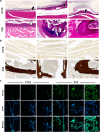Long noncoding RNA MALAT1 mediates fibrous topography-driven pathologic calcification through trans-differentiation of myoblasts
- PMID: 39205874
- PMCID: PMC11357808
- DOI: 10.1016/j.mtbio.2024.101182
Long noncoding RNA MALAT1 mediates fibrous topography-driven pathologic calcification through trans-differentiation of myoblasts
Abstract
Prosthesis-induced pathological calcification is a significant challenge in biomaterial applications and is often associated with various reconstructive medical procedures. It is uncertain whether the fibrous extracellular matrix (ECM) adjacent to biomaterials directly triggers osteogenic trans-differentiation in nearby cells. To investigate this possibility, we engineered a heterogeneous polystyrene fibrous matrix (PSF) designed to mimic the ECM. Our findings revealed that the myoblasts grown on this PSF acquired osteogenic properties, resulting in mineralization both in vitro and in vivo. Transcriptomic analyses indicated a notable upregulation in the expression of the long noncoding RNA metastsis-associated lung adenocarcinoma transcript 1 (Malat1) in the C2C12 myoblasts cultured on PSF. Intriguingly, silencing Malat1 curtailed the PSF-induced mineralization and downregulated the expression of bone morphogenetic proteins (Bmps) and osteogenic markers. Further, we found that PSF prompted the activation of Yap1 signaling and epigenetic modifications in the Malat1 promoter, crucial for the expression of Malat1. These results indicate that the fibrous matrix adjacent to biomaterials can instigate Malat1 upregulation, subsequently driving osteogenic trans-differentiation in myoblasts and ectopic calcification through its transcriptional regulation of osteogenic genes, including Bmps. Our findings point to a novel therapeutic avenue for mitigating prosthesis-induced pathological calcification, heralding new possibilities in the field of biomaterial-based therapies.
Keywords: Fibrous ECM mimicry; Malat1; Prosthesis-induced pathologic calcification; Trans-differentiation.
© 2024 The Authors.
Conflict of interest statement
The authors declare that they have no known competing financial interests or personal relationships that could have appeared to influence the work reported in this paper.
Figures










Similar articles
-
Long Noncoding RNA Metastasis-Associated Lung Adenocarcinoma Transcript 1 Promotes the Osteoblast Differentiation of Human Bone Marrow-Derived Mesenchymal Stem Cells by Targeting the microRNA-96/Osterix Axis.J Craniofac Surg. 2022 May 1;33(3):956-961. doi: 10.1097/SCS.0000000000008092. Epub 2021 Aug 27. J Craniofac Surg. 2022. PMID: 34456284
-
LncRNA metastasis-associated lung adenocarcinoma transcript-1 promotes osteogenic differentiation of bone marrow stem cells and inhibits osteoclastic differentiation of Mø in osteoporosis via the miR-124-3p/IGF2BP1/Wnt/β-catenin axis.J Tissue Eng Regen Med. 2022 Mar;16(3):311-329. doi: 10.1002/term.3279. Epub 2022 Jan 11. J Tissue Eng Regen Med. 2022. PMID: 34962086
-
Analysis of hypoxia-induced noncoding RNAs reveals metastasis-associated lung adenocarcinoma transcript 1 as an important regulator of vascular smooth muscle cell proliferation.Exp Biol Med (Maywood). 2017 Mar;242(5):487-496. doi: 10.1177/1535370216685434. Epub 2017 Jan 5. Exp Biol Med (Maywood). 2017. PMID: 28056547 Free PMC article.
-
The long noncoding RNA Malat1: Its physiological and pathophysiological functions.RNA Biol. 2017 Dec 2;14(12):1705-1714. doi: 10.1080/15476286.2017.1358347. Epub 2017 Oct 6. RNA Biol. 2017. PMID: 28837398 Free PMC article. Review.
-
LncRNA MALAT1 promotes osteoarthritis by modulating miR-150-5p/AKT3 axis.Cell Biosci. 2019 Jul 1;9:54. doi: 10.1186/s13578-019-0302-2. eCollection 2019. Cell Biosci. 2019. PMID: 31304004 Free PMC article. Review.
References
-
- Anderson H.C. Mechanisms of pathologic calcification. Rheum Dis Clin North Am. 1988;14:303–319. - PubMed
LinkOut - more resources
Full Text Sources

